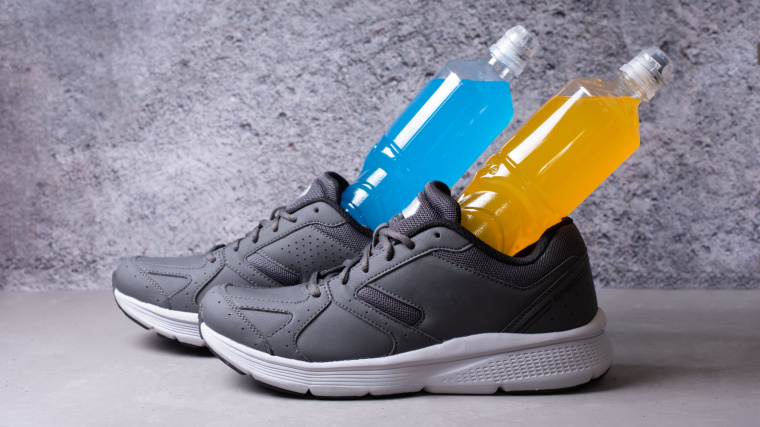Every year, marathon runners across the globe sign up to participate in races. On any given year, any of these distance athletes will be lining up to run the very first marathons of their lives. If you are a first-time runner, reaching the starting line is just as significant of an accomplishment as crossing the finish line — so congratulate yourself. You’re on your way.
But if you’re aiming to go the distance, you might be wondering where your training is measuring up. Approaching marathon training without understanding the capabilities of the average runner of your age group and gender can make training difficult.

Identifying the average marathon time for someone with your characteristics can help you establish an ideal marathon training plan, and finish with a race time you’ll be pleased with.
How Long Is a Marathon?
Legend has it that the length of a marathon was established by the run of the Athenian Pheidippides in 490 BC. Pheidippides reportedly ran 42.195 kilometers — or 26 miles and 385 yards, otherwise expressed as 26.2 miles — from the site of the Battle of Marathon to Athens in an effort to report the battle’s result. (1) As a result, the length of a marathon has been fixed at this distance thanks to its historical precedent.
What Is the Average Marathon Time?
Note: All running times have been taken from RunRepeat’s comprehensive study of marathon results. The study included more than 100 million race results recorded between 1986 and 2018. These time breakdowns do not include specific stats from nonbinary runners, who often must compete with other athletes from their assigned gender at birth.
The overall average marathon finish time is 4:26.33 — but this isn’t particularly useful to know for several reasons.

[Read More: The Best Fitness Trackers]
It disregards factors like an athlete’s age or gender, and it doesn’t account for the experience levels and preparation steps of each of the runners. To make a practical projection for what should be considered average to you, you’ll need to take additional data into account.
Average Beginning Runner Marathon Times
In general, you may be considered a “beginner” if you have trained to run consistently for at least one month but no longer than six months. (2) But if you’re attempting a marathon, chances are you’ve been training longer than that. In that case, you’re a beginner if you’re training for your first-ever marathon.
[Read More: The Best Treadmills]
Taking the bottom 20 percent of average finishing times provides an estimate of times for beginners. Of course, more experienced runners might still run at these paces, and some beginners may well run faster.
- Overall: 5:11.00 Mile Pace: 12:00
- Male: 4:55.33 Mile Pace: 11:20
- Female: 5:26.40 Mile Pace: 12:26
Average Novice Runner Marathon Times
If you’re a novice, you’re still in the beginner range, but have a bit more experience on your running shoes. You might have been training between six months all the way up to two years. (2)
If you’re getting ready to marathon with this level of experience, you likely have raced a couple of 5ks — and maybe even a half marathon.
- Overall: 4:38.30 Mile Pace: 10:41
- Male: 4:25.33 Mile Pace: 10:11
- Female: 4:53.37 Mile Pace: 11:16
Average Intermediate Runner Marathon Times
If you’ve been running consistently for between two to five years, you might consider yourself an intermediate runner. (2) As such, you are both experienced and well-conditioned.
Your fitness level is likely on point by now, and you’re used to distance running. While you might not be ready for an ultramarathon, a marathon might feel intimidating but still within reach.
- Overall: 4:15.09 Mile Pace: 9:48
- Male: 4:03.57 Mile Pace: 9:23
- Female: 4:31.21 Mile Pace: 10:25
[Read More: The Best Budget Treadmills]
Average Advanced Runner Marathon Times
Advanced runners have more than five years of running experience under their belts, and probably even train regularly with competition in mind. (2) At this stage, advanced runners will likely have devised strategies to implement during each segment of the race, and are well prepared to execute them.
- Overall: 3:49.53 Mile Pace: 8:50
- Male: 3:40.13 Mile Pace: 9:14
- Female: 4:06.58 Mile Pace: 9:27
Average Elite Runner Marathon Times
If you’re an elite runner, you have at least five years of experience behind you, and you’ve dedicated yourself to competing in the sport professionally. (2) Chances are, you consider it a minimum requirement to qualify for the most prestigious marathons in the world, and train diligently to secure the highest possible placement in those events.
- Overall: 2:50.48 Mile Pace: 6:34
- Male: 2:44.18 Mile Pace: 6:18
- Female: 3:11.35 Mile Pace: 7:20
Considerations of Age and Gender
For more prestigious races like the New York City Marathon or the Chicago Marathon, you have to qualify. Here is how the 2023 New York City Marathon qualifying times broke down by age and gender. (3)

[Read More: The Best Treadmills for Running]
There were three available gender categories for athletes hoping to qualify for this race: nonbinary, women, and men. Qualifying times for each of these gender categories are broken down into the following age brackets:
- 18-34
- 35-39
- 40-44
- 45-49
- 50-54
- 55-59
- 60-64
- 65-69
- 70-74
- 75-79
- 80+
Marathon Training Tips
If you show up untrained on the day of a scheduled marathon, you do so at your own peril. While it is true that many people could walk the entire length of a marathon if provided a nine-hour window, even that effort might be strenuous for many untrained athletes. Therefore, it is important to take the task of tackling a marathon seriously by following some critical steps.
Train the Miles
Marathon running may not be an exact science, but the scheduling of training leading up to a marathon has been pretty well optimized.
[Read More: Benefits of Walking for Strength Athletes]
Elite marathon runners of all genders typically run at least 100 miles per week over the course of 11 to 14 training sessions during the midpoint of their preparation. (4) Running plenty of miles in training will prepare you for the rigors of race day.
Train with Weights
Aside from completing the essential road work, strength training is hugely beneficial to distance runners, many of whom make room for it in their training schedules.

[Read More: 5 At-Home Workouts for Strength, Muscle Growth, Power, and More]
Specifically, 40 weeks of consistent weight training significantly improved the running economy and VO2 max of distance runners. (5) So even if you consider yourself strictly an endurance athlete, logging time with your favorite barbell exercises can go a long way toward improving your performance.
Get Some Rest
If you’re looking to log your fastest marathon, plan sufficient rest time into your training schedule. Marathon running severely challenges your body, and if you’re hoping to tackle such a long distance competitively, you’ll need to provide your body with ample recovery time during training. Many marathon runners take at least one full rest day each week.
Get the Footwear
Whether you’re a heel-, midfoot-, or forefoot-striker may be less of a contentious issue than it used to be amongst distance runners. Still, it is worthwhile to have a gait analysis conducted on your running form so that you’re not running a marathon in a pair of running shoes that actively impedes your performance.
Eat Correctly
Proper nutrition for athletes plays an invaluable role in your ability to sustain your training for a marathon, and during the marathon itself. High-carbohydrate diets remain the year-round norm for the world’s most elite distance runners. (6) In the 36 to 48 hours leading up to a race, eating a minimum of seven grams of carbs per kilogram of body mass is often suggested. (7)
Schedule Your Supplements
When you run a marathon, you are expected to eat and drink while your races are in progress. Your belt will likely carry gels, bars, and hydration aids that fuel you to cross the finish line. In fact.

[Read More: The Best Pre-Workout Supplements]
Not only should you make sure that you’re well stocked on race day, but you should use the supplements in bigger training sessions to gauge how well your body responds to them.
Get a Coach
If you intend to take marathon training seriously — or even if you’re merely questioning your ability to survive one — you may want to enlist the aid of a qualified running coach. Not only will a coach be great for your accountability during training, but an experienced coach can also spot form flaws and other correctable issues that you wouldn’t spot if you trained solo.
Forge Your Own Definition of Average
As you develop a plan to ascend into a higher tier of average, remember that comparing yourself against other runners is only so practical. Yes, it can be useful to know what your running competitors are doing, but you can never go wrong training solely to improve upon your past performances. That way, you always personally know at least one person worth chasing.
FAQs
If you’re interested in running your fastest marathon time, and one that is above average by whatever measure applies to you, here are some questions you might be interested in having answers to:
A good marathon time for an average cis man is 4:55.33 (11:20-minute mile pace), and a good marathon time for an average cis woman is 5:26.40 (12:26-minute mile pace).
Both of these times require a mile pace that significantly exceeds the 15 to 22-minute miles that the average person walks. (8)
To complete a marathon in three hours, you would have to maintain a race pace below seven minutes per mile, or more specifically an average pace of six minutes and 50 seconds.
The average marathon finish time irrespective of age and gender considerations is 4:26.33.
References
- “Battle of Marathon.” History. October 29, 2009. Last edited July 13, 2023.
- “Running Standards By Age And Ability.” Running Level.
- “Marathon Time Qualifiers.” 2023 TCS New York City Marathon. New York Road Runners.
- Haugen, T., Sandbakk, Ø., Seiler, S. et al. The Training Characteristics of World-Class Distance Runners: An Integration of Scientific Literature and Results-Proven Practice. Sports Med – Open 8, 46 (2022).
- Beattie, Kris1; Carson, Brian P.1; Lyons, Mark1; Rossiter, Antonia2; Kenny, Ian C.1. The Effect of Strength Training on Performance Indicators in Distance Runners. Journal of Strength and Conditioning Research 31(1):p 9-23, January 2017.
- Burke, L. M., Jeukendrup, A. E., Jones, A. M., & Mooses, M. (2019). Contemporary Nutrition Strategies to Optimize Performance in Distance Runners and Race Walkers. International Journal of Sport Nutrition and Exercise Metabolism, 29(2), 117-129.
- Burke LM. Nutrition Strategies for the Marathon: Fuel for Training and Racing. Sports Med. 2007;37(4-5):344-7.
- Rasmussen LJH, Caspi A, Ambler A, et al. Association of Neurocognitive and Physical Function With Gait Speed in Midlife. JAMA Netw Open. 2019;2(10):e1913123.
Featured Image: Real Sports Photos / Shutterstock